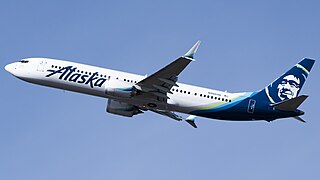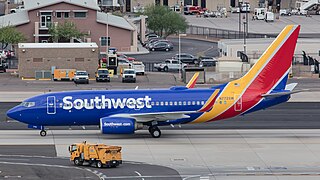
The Federal Aviation Administration (FAA) is the largest transportation agency of the U.S. government and regulates all aspects of civil aviation in the country as well as over surrounding international waters. Its powers include air traffic control, certification of personnel and aircraft, setting standards for airports, and protection of U.S. assets during the launch or re-entry of commercial space vehicles. Powers over neighboring international waters were delegated to the FAA by authority of the International Civil Aviation Organization.

The Boeing 787 Dreamliner is an American wide-body jet airliner developed and manufactured by Boeing Commercial Airplanes. After dropping its unconventional Sonic Cruiser project, Boeing announced the conventional 7E7 on January 29, 2003, which focused largely on efficiency. The program was launched on April 26, 2004, with an order for 50 aircraft from All Nippon Airways (ANA), targeting a 2008 introduction. On July 8, 2007, a prototype 787 was rolled out without major operating systems, and then the aircraft experienced multiple delays until its maiden flight on December 15, 2009. Type certification was received in August 2011 and the first 787-8 was delivered in September 2011 before entering commercial service on October 26, 2011, with ANA.
An Air Data Inertial Reference Unit (ADIRU) is a key component of the integrated Air Data Inertial Reference System (ADIRS), which supplies air data and inertial reference information to the pilots' electronic flight instrument system displays as well as other systems on the aircraft such as the engines, autopilot, aircraft flight control system and landing gear systems. An ADIRU acts as a single, fault tolerant source of navigational data for both pilots of an aircraft. It may be complemented by a secondary attitude air data reference unit (SAARU), as in the Boeing 777 design.

China Airlines Flight 120 was a regularly scheduled flight from Taiwan Taoyuan International Airport in Taoyuan County, Taiwan to Naha Airport in Okinawa, Japan. On August 20, 2007, the Boeing 737-800 aircraft operating the flight caught fire and exploded after landing and taxiing to the gate area at Naha Airport. Four people—three from the aircraft and one ground crew—sustained injuries in the accident. The fire had been caused by a loose bolt puncturing a fuel tank.

Qantas Flight 72 (QF72) was a scheduled flight from Singapore Changi Airport to Perth Airport by an Airbus A330. On 7 October 2008, the flight made an emergency landing at Learmonth Airport near the town of Exmouth, Western Australia, following an inflight accident that included a pair of sudden, uncommanded pitch-down manoeuvres that caused severe injuries—including fractures, lacerations and spinal injuries—to several of the passengers and crew. At Learmonth, the plane was met by the Royal Flying Doctor Service of Australia and CareFlight. Fourteen people were airlifted to Perth for hospitalisation, with 39 others also attending hospital. In all, one crew member and 11 passengers suffered serious injuries, while eight crew and 99 passengers suffered minor injuries. The Australian Transport Safety Bureau (ATSB) investigation found a fault with one of the aircraft's three air data inertial reference units (ADIRUs) and a previously unknown software design limitation of the Airbus A330's fly-by-wire flight control primary computer (FCPC).

Southwest Airlines Flight 2294 (WN2294/SWA2294) was a scheduled US passenger aircraft flight which suffered a rapid depressurization of the passenger cabin on July 13, 2009. The aircraft made an emergency landing at Yeager Airport (CRW) in Charleston, West Virginia, with no fatalities or major injuries to passengers and crew. An NTSB investigation found that the incident was caused by a failure in the fuselage skin due to metal fatigue.

Qantas Flight 32 was a regularly scheduled passenger flight from London to Sydney via Singapore. On 4 November 2010, the aircraft operating the route, an Airbus A380, suffered an uncontained failure in one of its four Rolls-Royce Trent 900 engines. The failure occurred over the Riau Islands, Indonesia, four minutes after takeoff from Singapore Changi Airport. After holding for almost two hours to assess the situation, the aircraft made a successful emergency landing at Changi. No injuries occurred to the passengers, crew, or people on the ground, despite debris from the aircraft falling onto houses in Batam.

Southwest Airlines Flight 812 was a Boeing 737-300 passenger jet that on April 1, 2011, suffered rapid depressurization while cruising at 34,000 ft (10,000 m) near Yuma, Arizona, leading to an emergency landing at Yuma International Airport. Two of the 123 people on board suffered minor injuries. The aircraft was operating Southwest Airlines' domestic scheduled service from Phoenix, Arizona, to Sacramento, California.

The Boeing 737 MAX is the fourth generation of the Boeing 737, a narrow-body airliner manufactured by Boeing Commercial Airplanes, a division of American company Boeing. It succeeds the Boeing 737 Next Generation (NG) and competes with the Airbus A320neo family. The new series was announced on August 30, 2011. It took its maiden flight on January 29, 2016 and was certified by the United States Federal Aviation Administration (FAA) in March 2017. The first delivery was a MAX 8 in May 2017 to Malindo Air, with which it commenced service on May 22, 2017.

In 2013, the second year of service for the Boeing 787 Dreamliner, a widebody jet airliner, several aircraft suffered from electrical system problems stemming from its lithium-ion batteries. Incidents included an electrical fire aboard an All Nippon Airways 787 and a similar fire found by maintenance workers on a parked Japan Airlines 787 at Boston's Logan International Airport. The United States Federal Aviation Administration (FAA) ordered a review into the design and manufacture of the Boeing 787 Dreamliner, followed by a full grounding of the entire Boeing 787 fleet, the first such grounding since that of the McDonnell Douglas DC-10 in 1979. The plane has had two major battery thermal runaway events in 52,000 flight hours, which was substantially less than the 10 million flight hours predicted by Boeing, neither of which were contained safely.

American Airlines Flight 383 was a scheduled passenger flight from O'Hare International Airport in Chicago, Illinois to Miami International Airport. On October 28, 2016, the Boeing 767-300ER operating the flight suffered an engine fire during takeoff. The crew aborted their takeoff, evacuating everyone on board, of whom 21 were injured. The plane was a write-off.
This is a list of aviation-related events in 2018.

Southwest Airlines Flight 1380 was a Boeing 737-700 that experienced an uncontained engine failure in the left CFM56-7B engine after departing from New York–LaGuardia Airport en route to Dallas Love Field on April 17, 2018. The engine cowl was broken in the failure and cowl fragments damaged the fuselage, causing explosive depressurization of the aircraft after damaging a cabin window. Other fragments caused damage to the wing. The crew carried out an emergency descent and diverted to Philadelphia International Airport. One passenger was partially ejected from the aircraft and sustained fatal injuries, while eight other passengers sustained minor injuries. The aircraft was substantially damaged.

The Boeing 737 MAX passenger airliner was grounded worldwide between March 2019 and December 2020 – longer in many jurisdictions – after 346 people died in two similar crashes: Lion Air Flight 610 on October 29, 2018 and Ethiopian Airlines Flight 302 on March 10, 2019. The U.S. Federal Aviation Administration (FAA) resisted grounding the aircraft until March 13, 2019, when it received evidence of accident similarities. By then, 51 other regulators had already grounded the plane, and by March 18, 2019, all 387 of the aircraft in service were grounded.

The Maneuvering Characteristics Augmentation System (MCAS) is a flight stabilizing feature developed by Boeing that became notorious for its role in two fatal accidents of the 737 MAX, which killed all 346 passengers and crew among both flights. Systems similar to the Boeing 737 MCAS were previously included on the Boeing 707 and Boeing KC-46, a 767 variant.

The two fatal Boeing 737 MAX crashes in October 2018 and March 2019 which were similar in nature – both aircraft were newly delivered and crashed shortly after takeoff – and the subsequent groundings of the global 737 MAX fleet drew mixed reactions from multiple organizations. Boeing expressed its sympathy to the relatives of the Lion Air Flight 610 and Ethiopian Airlines Flight 302 crash victims, while simultaneously defending the aircraft against any faults and suggesting the pilots had insufficient training, until rebutted by evidence. After the 737 MAX fleet was globally grounded, starting in China with the Civil Aviation Administration of China the day after the second crash, Boeing provided several outdated return-to-service timelines, the earliest of which was "in the coming weeks" after the second crash. On October 11, 2019, David L. Calhoun replaced Dennis Muilenburg as chairman of Boeing, then succeeded Muilenburg's role as chief executive officer in January 2020.

The Boeing 737 MAX was initially certified in 2017 by the U.S. Federal Aviation Administration (FAA) and the European Union Aviation Safety Agency (EASA). Global regulators grounded the plane in 2019 following fatal crashes of Lion Air Flight 610 and Ethiopian Airlines Flight 302. Both crashes were linked to the Maneuvering Characteristics Augmentation System (MCAS), a new automatic flight control feature. Investigations in both crashes determined that Boeing and the FAA favored cost-saving solutions, but ultimately produced a flawed design of the MCAS instead. The FAA's Organization Designation Authorization program, allowing manufacturers to act on its behalf, was also questioned for weakening its oversight of Boeing.

On February 20, 2021, United Airlines Flight 328 (UA328/UAL328), a scheduled U.S. domestic passenger flight from Denver to Honolulu, suffered a contained engine failure four minutes after takeoff from Denver International Airport (DEN). Parts departing from the engine cowling of the Boeing 777-222 aircraft resulted in a debris field at least 1 mile (1.6 km) long over suburban residential areas of Broomfield, Colorado. Falling debris was recorded by eyewitnesses using smartphone cameras and a dash cam. Debris fell through the roof of a private home and significantly damaged a parked vehicle.

Alaska Airlines Flight 1282 was a scheduled U.S. domestic flight operated by Alaska Airlines from Portland International Airport in Oregon to the Ontario International Airport in California. Shortly after takeoff on January 5, 2024, a door plug installed at the factory in place of an optional emergency exit door on the Boeing 737 MAX 9 aircraft blew out, causing an uncontrolled decompression of the aircraft. The aircraft was immediately diverted back to Portland for an emergency landing. All 171 passengers and 6 crew members survived the accident. The National Transportation Safety Board (NTSB) is investigating the cause of this accident.
















